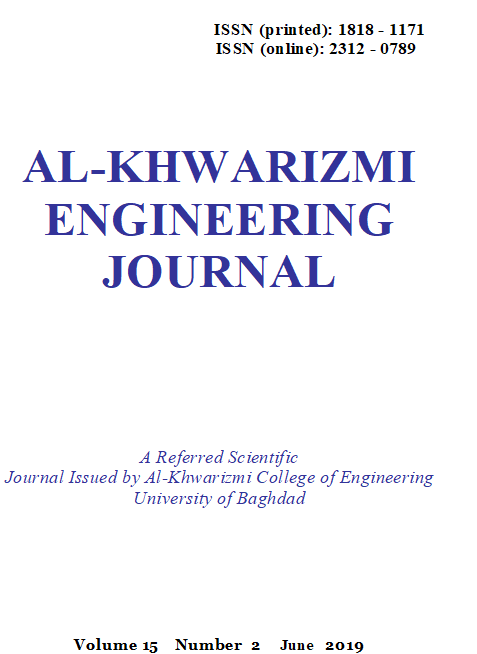Treatment of Waste Extract Lubricating Oil by Catalytic Cracking Process to Produce Light Fractions
Abstract
The catalytic cracking of three feeds of extract lubricating oil, that produced as a by-product from the process of furfural extraction of lubricating oil base stock in AL-Dura refinery at different operating condition, were carried out at a fixed bed laboratory reactor. The initial boiling point for these feeds was 140 ºC for sample (1), 86 ºC for sample (2) and 80 ºC for sample (3). The catalytic cracking processes were carried out at temperature range 325-400 ºC and initially at atmospheric pressure after 30 minutes over 9.88 % HY-zeolite catalyst load. The comparison between the conversion at different operating conditions of catalytic cracking processes indicates that a high yield was obtained at 375°C, according to gasoline production. The distillation of cracking liquid products was achieved by general ASTM distillation (ASTM D -86) for separation of gasoline fraction up to 220 ºC from light cycle oil fraction above 220 ºC. According to gasoline production, it can be noticed that the condition of the feed with the lowest initial boiling point (80 ºC) (sample 3) made it gives more production of gasoline as compared with the other feeds (sample 1,2). At the best temperature (375 ºC), for the best feed for the production of gasoline (sample (3)), the production of gasoline + kerosene were 19.315, 16.16 and 12.95 wt.% for sample (2, 3 and 1). The RON for the gasoline produced from the catalytic cracking for the feed of the lowest initial boiling point was 92.3.
Downloads
References
R. Sadeghbeigi, “Fluid Catalytic Cracking Handbook: Design, Operation and Troubleshooting of FCC Facilities. 2000.” Gulf Publishing Company. Houston, TX, 2000.
The, “HYDROCARBON STRUCTURE AND CHEMISTRY: AROMATICS,” 2005.
The petroleum HPV testing Group, “Aromatic Extracts Category,” 2008.
Hobson and G. Douglas, “Modern petroleum technology,” 1973.
J. H. Gary and G. E. Handwerk, Petroleum refining: technology and economics, 4th ed. Marcel Dekker, New York, 2001.
R. Sadeghbeigi, “Fluid Catalytic Cracking Handbook,” Gulf Publishing Company. Houston, 1995.
D. W. Breck, Zeolite molecular sieves: structure, chemistry and use. John Wiley, New York, 1974.
E. M. Flanigen, R. W. Broach, and S. T. Wilson, “Introduction,” Zeolites Ind. Sep. Catal., pp. 1–26, 2010.
B. Delmon, G. Ertl, H. Knözinger, and J. Weitkamp, “Handbook of heterogeneous catalysis,” Handb. Heterog. Catal., p. 2039, 1997.
J. Scherzer, Octane-enhancing zeolitic FCC catalysts. Dekker, New York, 1990.
W.-C. Cheng et al., “Environmental fluid catalytic cracking technology,” Catal. Rev., vol. 40, no. 1–2, pp. 39–79, 1998.
Y. Syamsuddin, B. H. Hameed, R. Zakaria, and A. R. Mohamed, “Thermal and catalytic cracking of petroleum residue oil,” Eng. J. Univ. Qatar, vol. 18, pp. 1–8, 2005.
K. K. Esgair, R. G. Yousuf, and A. H. A. K. Mohammed, “Cracking activity of prepared Y-zeolite catalyst using cumene on fluidized bed reactor,” Iraqi J. Chem. Pet. Eng., vol. 12, no. 2, pp. 9–17, 2011.
A. H. A. K. Mohammed, I. K. Shakir, and K. K. Esgair, “The Use of Prepared Zeolite Y from Iraqi Kaolin for Fluid Catalytic Cracking of Vacuum Gas Oil,” J. Eng., vol. 19, no. 10, pp. 1256–1270, 2013.
A. M. Rahman, M. H. Salman, and K. W. Hammed, “Catalytic Cracking of Iraqi Vacuum Gasoil Using Large and Medium Pore Size of Zeolite Catalysts,” Al-Khwarizmi Eng. J., vol. 11, no. 1, pp. 73–83, 2014.
M. LISTAK and V. OJA, “ASTM D86 DISTILLATION IN THE CONTEXT OF AVERAGE BOILING POINTS AS THERMODYNAMIC PROPERTY OF NARROW BOILING RANGE OIL FRACTIONS.,” Oil Shale, vol. 35, no. 3, 2018.
K. K. Esgair, “Fluid catalytic cracking of petroleum fraction (vacuum gas oil) to produce gasoline,” University of Baghdad, 2010.
A. G. Maadhah et al., “A NEW CATALYTIC CRACKING PROCESS TO MAXIMIZE REFINERY PROPYLENE.,” Arab. J. Sci. Eng. (Springer Sci. Bus. Media BV), vol. 33, pp. 17–27, 2008.
D. Decroocq, Catalytic cracking of heavy petroleum fractions. Editions Technip, 1984.
A. A. Lappas, D. K. Iatridis, and I. A. Vasalos, “Production of reformulated gasoline in the FCC unit. Effect of feedstock type on gasoline composition,” Catal. today, vol. 50, no. 1, pp. 73–85, 1999.
D. Stratiev et al., “Effect of Feedstock Properties on Conversion and Yields,” OIL GAS-EUROPEAN Mag., vol. 43, no. 2, pp. 84–89, 2017.
Mike, “DHI Spill Data Analysis Data Sheet: Data Sheets For Diffetent Oil, Heavy Fuel Oil,” pp. 9–10, 2017.
P. Ghosh, K. J. Hickey, and S. B. Jaffe, “Development of a detailed gasoline composition-based octane model,” Ind. Eng. Chem. Res., vol. 45, no. 1, pp. 337–345, 2006.
P. T. M. Do, S. Crossley, M. Santikunaporn, and D. E. Resasco, “Catalytic strategies for improving specific fuel properties,” Catalysis, vol. 20, pp. 33–64, 2007.
Ministry of oil Republic of Iraqi,“Marketing Specification guide of Iraqi petroleum,” 2013.
Downloads
Published
Issue
Section
License
Copyright: Open Access authors retain the copyrights of their papers, and all open access articles are distributed under the terms of the Creative Commons Attribution License, which permits unrestricted use, distribution, and reproduction in any medium, provided that the original work is properly cited. The use of general descriptive names, trade names, trademarks, and so forth in this publication, even if not specifically identified, does not imply that these names are not protected by the relevant laws and regulations. While the advice and information in this journal are believed to be true and accurate on the date of its going to press, neither the authors, the editors, nor the publisher can accept any legal responsibility for any errors or omissions that may be made. The publisher makes no warranty, express or implied, with respect to the material contained herein.












